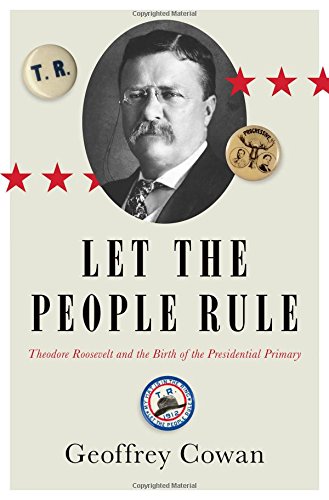
Let the People Rule
Theodore Roosevelt and the Birth of the Presidential Primary
کتاب های مرتبط
- اطلاعات
- نقد و بررسی
- دیدگاه کاربران
نقد و بررسی

November 23, 2015
In this timely, engaging story of Teddy Roosevelt’s role in changing how political parties choose their presidential nominees, Cowan (The People v. Clarence Darrow), director of the Annenberg School’s Center on Communication Leadership and Policy at the University of Southern California, presents the 26th president as a conflicted, reluctant champion of popular democracy. Roosevelt served nearly two full terms as president (1901–9) before taking a hiatus from politics. Friends and supporters urged him to run again in 1912 to keep the Republican Party on a reformist course. However, Roosevelt’s personally groomed successor, William Howard Taft, refused to give up hopes for a second term, setting the stage for a fight at the nominating convention. Roosevelt knew he had to capitalize on his popularity, so the manner of choosing delegates and who they represented was critically important to securing the nomination. Cowan writes with a Rooseveltian verve, focusing on the political processes without losing sight of the major personalities who were involved as Roosevelt, Taft, and Robert La Follette jockeyed for the 1912 nomination. He also portrays Roosevelt as an opportunist who manipulated race and gender issues to further his candidacy. Roosevelt introduced an important change to the nominating process, but Cowan shows that it cost him and the Republicans the White House. Illus.

October 1, 2015
The history of the 1912 battle among Theodore Roosevelt, William Howard Taft, and Robert La Follette for the presidency of the United States, which gave birth to the first presidential primary. Cowan (Annenberg Family Chair in Communication Leadership/Univ. of Southern California; The People v. Clarence Darrow: The Bribery Trial of America's Greatest Lawyer, 1993, etc.) brings to life the wheeler-dealers, back-alley shenanigans, and political intrigue embedded within this legislative saga. He ably shows how the resulting primary system continues to affect our current political theater. Readers' perceptions of Roosevelt and his motivations may change a bit after reading Cowan's assessment of him. The author notes that his interest in writing the book lay in what transpired when Roosevelt created the Bull Moose Party, which bore the slogan of "the right of the people to rule," and then proceeded to exclude black delegations from the states comprising the Deep South. Though Cowan's portrait of Roosevelt forms the core of the book, the author fleshes out the personalities and motivations of many other influential characters. Cowan's straightforward explanation of the role played by the prominent newspapers of the era provides an entertaining lens for viewing how outside influences create opinion and help contribute to the process of a presidential election. Readers who may feel overwhelmed by today's political climate should take heart in noting how the past was not all that much different. "Insiders knew that the convention itself]the fight over the temporary roll, over the permanent chairmanship, even over the credentials challenges]was theater, for effect, for public consumption," writes Cowan, whose use of material "from dozens of previously unknown and unused manuscript collections," adds depth to his portrait of Roosevelt and the social and cultural environments from which the presidential primary emerged. Political junkies will delight in this rollicking history containing lessons applicable to our contemporary political landscape.
COPYRIGHT(2015) Kirkus Reviews, ALL RIGHTS RESERVED.

February 15, 2016
The 1912 presidential election was the first one in which primaries played a significant role. Despite Theodore Roosevelt winning nine of the 13 Republican primaries, William H. Taft was renominated because of his strong support among delegates chosen at state nominating conventions, says Cowan (Annenberg Family Chair in Communication Leadership, Univ. of Southern California; The People v. Clarence Darrow), in this lively, deeply researched narrative, which takes readers from primary season through the convention, and to Roosevelt and his supporters bolting to form the upstart, progressive Bull Moose Party. Cowan is at his best when revealing Roosevelt's cynical manipulation of black voters, who were encouraged to become Bull Moosers in the North but were forbidden to become convention delegates if they lived in the Jim Crow South. Despite this ploy, Roosevelt was trounced in the South by Democrat Woodrow Wilson, the election's victor. Cowan concludes that the emergence of primaries was the election's enduring legacy. VERDICT Both general readers and historians will enjoy the book's you-are-there feel because of Cowan's excellent use of primary documents. See also Louis Gould's Four Hats in the Ring and Doris Kearns Goodwin's The Bully Pulpit, two works that capture the election's spirit and discuss in detail Roosevelt and Taft's volatile relationship.--Karl Helicher, Upper Merion Twp. Lib., King of Prussia, PA
Copyright 2016 Library Journal, LLC Used with permission.

























دیدگاه کاربران